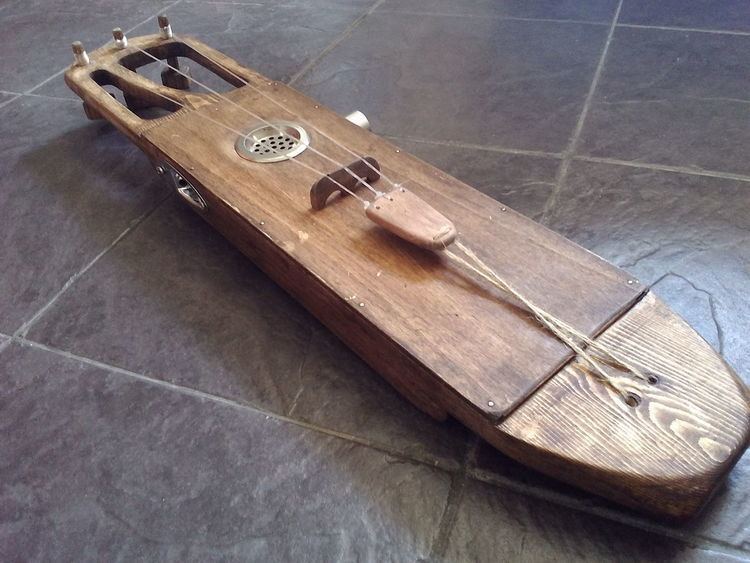 | ||
The jouhikko is a traditional, two- or three-stringed bowed lyre, from Finland and Karelia. Its strings are traditionally of horsehair. The playing of this instrument died out in the early 20th century but has been revived and there are now a number of musicians playing it.
Contents
Name
The Jouhikko is also called jouhikannel or jouhikantele, meaning a bowed kantele. In English, the usual modern designation is 'bowed lyre' though the earlier preferred term 'bowed harp' is also met with. There are many different names for the instrument and for its close relatives in neighbouring regions.
History
The early history of the jouhikko is obscure, not least because of the many related instruments from neighbouring regions. Perhaps the earliest definite depiction of this kind of instrument is the stone carving from Trondheim Cathedral, Norway, dating from the second quarter of the 14th century.
18th-century writers in Latin mention instruments that seem to be a jouhikko, but the first illustration comes from c. 1830 CE. Folk music collectors in the late 19th and early 20th century visited players in Finland and Karelia, and collected instruments, noted tunes, made field recordings and took photographs.
Repertory
The jouhikko repertory was mostly collected in the field by A. O. Väisänen from 1913 to 1961. The jouhikko was used for playing dance music, and the collected tunes are very short, and were largely improvised. The scale of the jouhikko is only 6 notes, with a constantly sounding drone.
Tuning
In a three-string jouhikko, the middle string, or in a two-string instrument, the lower or left hand string, is the drone string. Absolute pitch is not fixed, but in Nieminen's charts this is given the note d. The upper or right hand string, passing over the finger-hole, is fingered to give a scale, and this scale typically runs upwards from the note a 4th above the drone, or in Nieminen's charts, g a b c d e. The third or left hand string can be tuned down to a lower drone, or up to provide one of the melody notes.
Playing technique
The strings are stopped by touching them with the back of the fingers (the knuckles or nails), as there is no fingerboard to press the strings against. This fingering method is rather similar to the igil or the sarangi which also lack fingerboards. To touch the melody string the hand is inserted through a hole in the flat wooden board that makes up the top third of the instrument.
On a 3-string instrument tuned g-d-a, the first note of the scale is played on the g string, which cannot be fingered as it lies on the far side of the drone and out of reach of the hand hole. The second note is the a string played open. The third, fourth, fifth and sixth notes of the scale are played with the backs of the four fingers, stopping the a string. Whilst it is possible to play higher notes by moving the hand further up the string all the traditional melodies are within a compass of six notes, the first six notes of either a major or minor scale.
Modern revival
Modern instruments are made with carbon fibre, nylon, gut or even metal viola strings instead of the traditional horsehair. Following Estonian talharpa technique, the hand hole is often made larger so that the hand can be inserted between the first and second strings, stopping the first with the insides of the fingers and the second with the outside
The most prominent recent use of the jouhikko is the Finnish folk band Jouhiorkesteri, whose member Rauno Nieminen is considered to be the modern master of the instrument. Other bands using jouhikko include Finnish folk metal band Korpiklaani and Estonian folk metal band Raud-Ants.
Kvitrafn (Einar Selvik) of the Norwegian traditional/folk band Wardruna uses his own made Jouhikko on their 2009 album Runaljod - Gap Var Ginnunga.
Related instruments
The jouhikko is a member of a family of bowed lyre type instruments that stretches from Russia in the east, through Scandinavia, to Britain and Ireland. Most of these regions have only very sketchy evidence about their extinct bowed lyre traditions. The four-stringed Estonian talharpa and hiiu kannel have a wider hand hole and can play a wider range and shifting drones. The Welsh crwth is the most developed of this family to survive, with six strings, a fingerboard, and a complex playing style. Extinct or obscure variants include the Shetland gue and the English crowd. Other instruments are perhaps less closely related, including the bowed zithers such as the Finnish harppu, Icelandic fiðla, and the North American Inuit tautirut.
